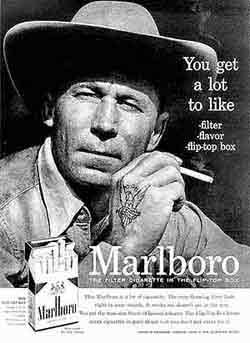Iconic Ads: Marlboro – Come To Where The Flavour is

Advertising urged smokers and non-smokers equally to try out Marlboro. Here was the Cowboy’s invitation
Marlboro was first advertised in the 1920s as a luxury cigarette for women. This milder form was also what well-dressed men enjoyed after dinner. However, by the 1950s, many smokers had shifted to filtered brands due to concerns about smoking and cancer. Rather than re-run the old advertising, Philip Morris relaunched Marlboro as the company’s filtered cigarette product (Marlboro did not have one earlier)
It was not easy. Marlboro had to deal with the brand’s feminine image. Also, filtered cigarettes were seen as gentler versions of the real thing, cigarettes for sissies.
Marlboro identified the trend of the idealized smoker through market research. The tobacco industry tried to ally fears about the harmful effects of cigarette smoking by lowering risk by using sophisticated jargon and scientific claims about the filter.
Leo Burnett was in charge of relaunching Marlboro as a men’s cigarette.
Leo Burnett employed an altogether different approach, creating advertising that made no health claims about the filtered cigarette. Burnett felt that making promises about filter efficiency exacerbated concerns about smoking’s long-term effects.
Instead of telling customers to be safe, they agreed to say something completely different. Stating the risk and, more importantly, implying that smoking was about independence…own man…do what you want!
They came up with their idea and icon during a brainstorming session at the agency.
‘What is the most macho symbol you can think of?’ Burnett inquired. And one of these writers blurted out a cowboy. ‘That’s for sure,’ Burnett replied.
This series was to start with the cowboy. Burnett got the idea for the overtly masculine “Marlboro Man” image from a 1949 issue of Life magazine, which included a portrait (taken by Leonard McCombe) and an article about Texas cowboy Clarence Hailey Long.

The first Marlboro men weren’t only cowboys. They were tough guys who smoked while fixing cars, fishing, or hunting. To be included in the ad were sea captains, weightlifters, war correspondents and other macho sorts.
A Navy Lieutenant and Andy Armstrong, the art supervisor at the ad agency, were the first models. Other early models included Philip Morris’ sales promotion director, Robert Larking, Lee Stanley and Owen Smith from the Leo Burnett advertising agency.
‘Come to where the flavour is,’ it urged smokers and non-smokers equally. Here was the main seductive man’s invitation.
The advertising was a hit. Cigarette sales topped $5 billion in 1955, a 3000% increase from the year before. Before he appeared on televisions and billboards, the Marlboro Man had a 1% market share. After a year, the company was fourth in the US. Since 1972, it has been the best-selling brand.
Someone at Leo Burnett noticed a slight increase in sales every time a cowboy was featured. So they dropped all of the others & focus on the cowboy theme. That fit American society in the 1950s and 1960s, when Westerns like Gunsmoke and Maverick were on TV and kids dressed up as cowboys and Indians.
The advertising also grew to talk about Marlboro Country and so on…..







